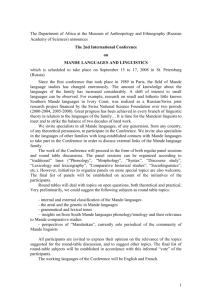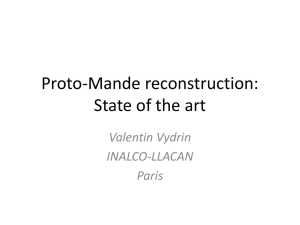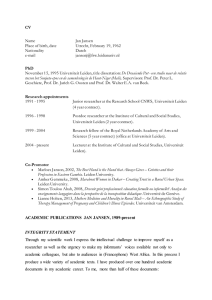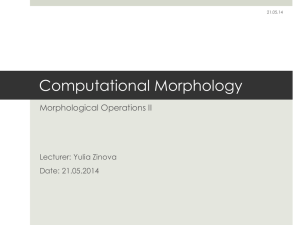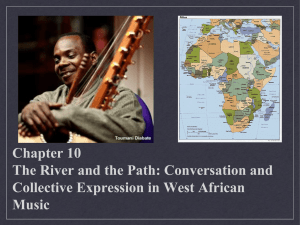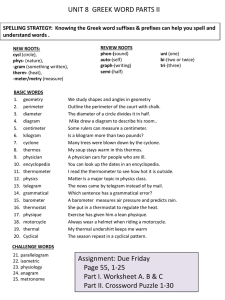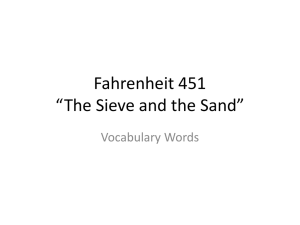Vydrin, Valentin. Towards Proto-Mande
advertisement
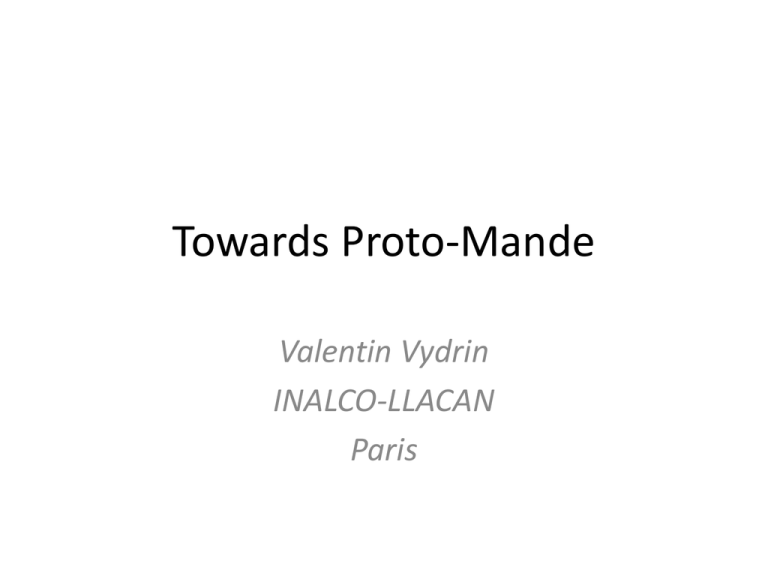
Towards Proto-Mande Valentin Vydrin INALCO-LLACAN Paris Mande languages 60 to 75 languages, two branches • Western: Manding, Mokole, Vai-Kono, JogoJeri, Susu-Southwestern, Soninke-Bozo, Samogho, Bobo groups; • South-Eastern: Southern, Eastern groups. Genetic depth • About 5300 years ago, separation of Western and Southeastern branches (17-20% between the most distant groups, Southwestern and Eastern, which corresponds to about 6000 years) • Daughter groups, 1000 to 3500 years: Manding 1200; Mokole 1500; Jogo-Jeri 1700; Southwestern 2000; Sononke-Bozo 3100; Southern 2600; Eastern 3100. Proto-Mande phonological system Some crucial features: - Nasal and ATR harmony; - No nasal consonants; - Implosive / sonants; - Highly probably, metric foot. 9 oral and 5 nasal vowels; ATR and nasal harmony (domain: metric foot) Syllabic types: *CV, *CVŋ (*CVN) + ATR *i *e *u *o *a –ATR *ɩ *ɛ *ʋ *ɔ *a Nasal series *N *ĩ *ẽ *ũ *õ *ã Consonants: • No phonemic nasal consonants (implosives and sonants have nasal allophones) • Opposition “implosive : explosive consonants” Phoneme /ɓ/ /ɗ/ /y/ /w/ Oral allophone [ɓ] [ɗ] [y] [w] Nasal allophone [m] [n] [ɲ] [ŋ] The main argument for this system: Quasi-absence of sequences “nasal consonant + semi-closed vowel” in Western Mande (ex.: Bamana) PM *be *bɛ *bẽ *beŋ *bɛŋ *bẽŋ > > > > > > Bamana PM be bɛ bɛ̃ bẽ bɛ̃ bɛ̃ *ɓe *ɓɛ *mẽ *ɓeŋ *ɓɛŋ *mẽŋ Bamana > > > > > > be bɛ mɛ̃ bẽ bɛ̃ mɛ̃ All Mande languages are tonal • Western Mande: 2 level tones (exceptions: S. Kpelle, 3 tones; Samogho group, 3 to 4 tones; Bobo, 3 tones) • Southeastern Mande: 3 to 5 level tones • Proto-Mande: presumably, 2 level tones. • Tonal split in daughter languages through tone-depressor consonants (ex.: Guro; probably, Boko) and foot compression. Noun morphology reconstructon • Noun morphology in modern Mande languages is scanty and/ or innovative. • No noun classes. • Some remnants of classificatory morphology (not necessarily noun classes): Nasal prefix *Ǹ- (small objects, dangerous objects... etc.), reflexes: 1) prenasalization of certain nouns in Bamana, Mandinka; 2) perturbaton of initial consonant alternation in Southwestern Mande 3) no article/noun morpheme in numerous Western Mande languages 4) irregular correspondences in Southern Mande. Nouns for elder relatives: • “strong” unalterable initial consonants in Southwestern Mande; • special plural marker -NI in SWM; • no article/noun morpheme added in numerous Western Mande languages. Reconstruction: prefix *Ń-, pl. suffix *-ni (?). Opposition “alienable : inalianable” (“free noun : relational noun”) • Is to be reconstructed for the Proto-Mande • The alienable possession markers are variable in the Mande languages and stem from different locative postpositions. Cf. Dan where different possessive markers encode opposition of cases (ɓȁ common case vs. gɔ ̏ locative case), an evident innovation. An intriguing evidence: • Proto-Southwestern Mande agent noun suffix: • Sg. *–mɔ, • Pl. *–bèlà. Are these forms to be traced back to the NC 1 and 2 class markers? Pronominal morphology • Single paradigms in the Central Mande (Manding, Mokole, Vai-Kono, Jogo-Jeri, Soninke-Bozo); • Multiple paradigms (different syntactic functions, pragmatic and TAM semantics) in Southwestern Mande, Southern and Eastern Mande, Bobo. Probably, more than one series in Proto-Mande. Verbal morphology • Very little derivational morphology in modern Mande languages: - -ndi causative suffix in Mandinka, -ndí in Soninke, -ni in Bozo - Antipassive ndì in Soninke, -rí in Mandinka. Creissels’ hypothesis: from the verb *tîŋ ‘do’. - Decausative suffix –E in Soninke, Bozo (in a fossilized form, also in Bobo). Further derivational morphology: • -be causative suffix in Bobo, -ke causative suffix in Gban (Southern Mande); • Verbal locative suffix *-Lá in Southern Mande, *-LƐ in Busa-Bokobaru (Eastern Mande) < from adverb *tá ‘there’ (Idiatov 2008). • Verbal prefixes in Manding, SWM, SM, Susu, etc. are innovations. We may relax: The scanty verbal derivative morphology in Mande languages is innovative, there is hardly anything that can be reconstructed for the Proto-Mande level. TAM morphology • Basic word order: S Aux DO V-mrph Two major slots form auxiliary morphemes: Aux, -mrph. Majour sources for Aux: copulae, motion verbs, verb “do”. Sources for –mrph: locative postpositions, converb suffixes. Some candidates for the PM-level reconstruction, position Aux: • TE, negative copula • BE, affirmative locative copula • MU, presentative/ identification copula Candidates for the PM level, slot -mrph • Gerund marker *-ɗɩ • Perfect marker –DA. Everything else is presumably innovative (to be verified!). A preliminary conclusion: The main bulk of evidence pro or contra NC origin of Mande lies in the field of the lexical + phonological reconstruction. The morphology reconstructable for the ProtoMande language is too scarce to serve a proof of anything (which does not mean that a reconstruction of the Mande morphology is useless!). Phonological reconstruction: mainly initial consonants Reliable reconstructions: - Proto-Southwestern - Proto-Southern - Proto-Manding (to be updated in certain fragments), initial + internal consonants + vowels Less reliable: - “Proto-Western” (in fact, SWM + Susu + Manding + Vai-Kono) by R.Kastenholz; - “Proto-Eastern” by H.Schreiber (rather unreliable). Lexical reconstruction • Comparative database, about 3070 comparative series by now (of various degree of elaboration), of these presumably 500-600 represent more or less probable candidates for the Proto-Mande level. Their children will certainly see a reliable Proto-Mande reconstruction!
